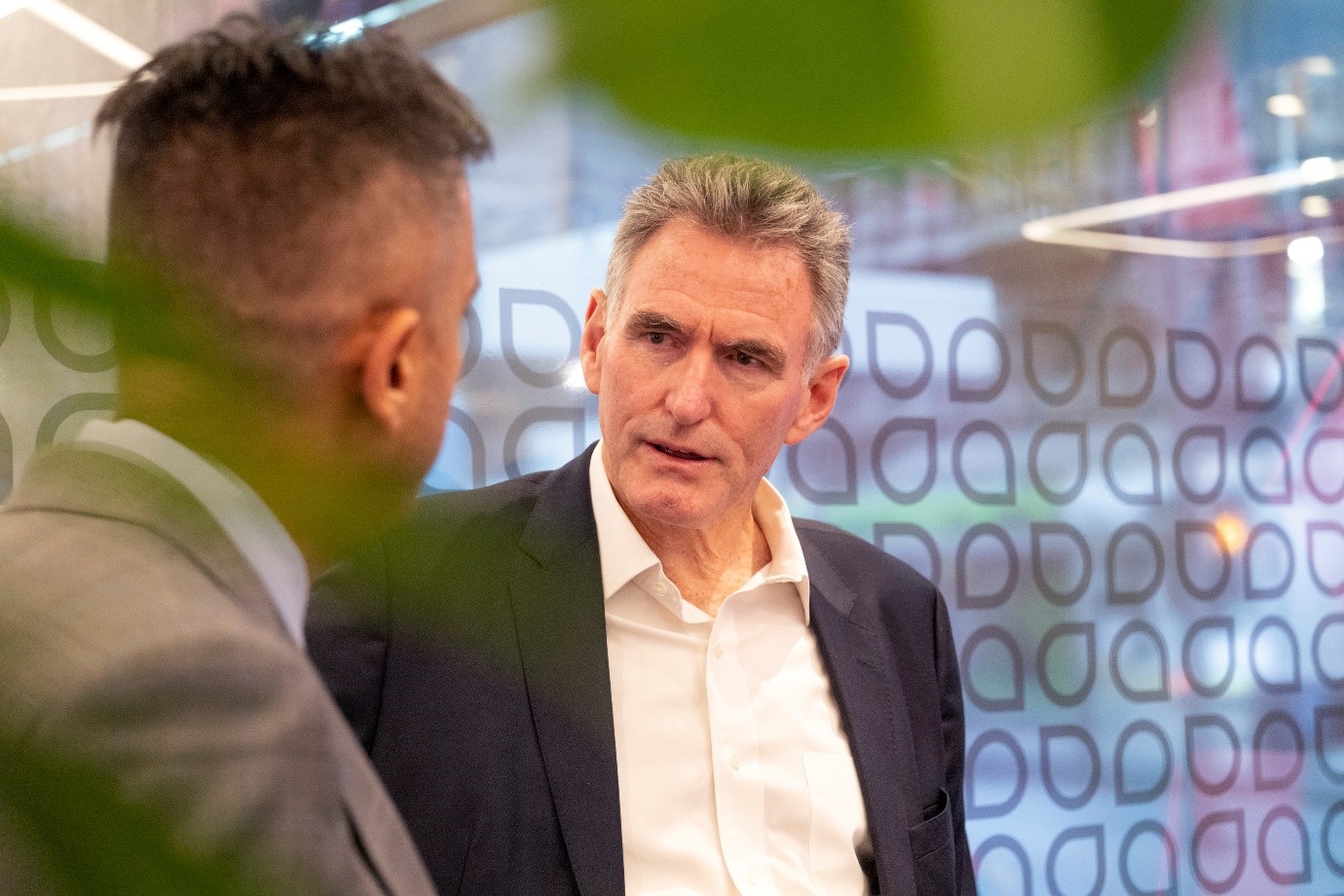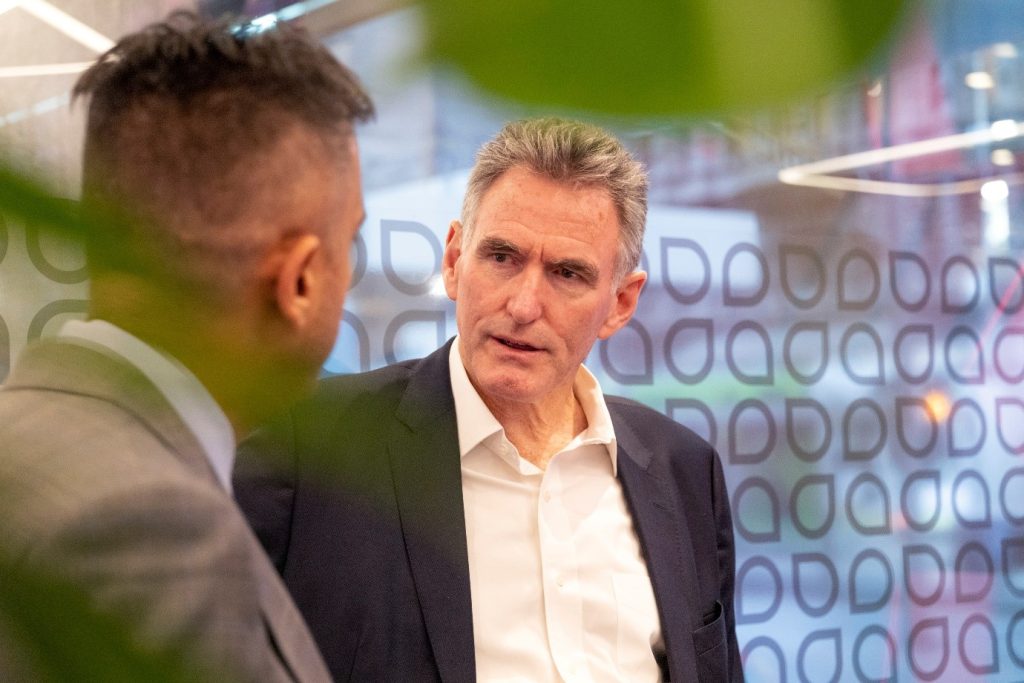Below is transcript from a May 5 2022 media conference with NAB CEO Ross McEwan.
NAB GROUP CEO, ROSS McEWAN:
Thank you for joining us this morning. I’d like to start with some short remarks about our results as well as both interest rates and NAB’s Enforceable Undertaking with AUSTRAC. Then I’m happy to take questions.
On our results, I’m pleased to say we’ve put up another strong set of numbers. Compared with September 2021, revenue grew by 5.5% – benefitting from 5% growth in lending and 6% growth in deposits. Costs were flat with productivity savings offsetting emerging inflationary pressures and the investment made to support growth. This has translated into 10.2% growth in underlying profit and 8.2% growth in cash earnings relative to September 2021.
The first half dividend is 73cps, fully franked. Disciplined execution of our strategy, and the investments we are making, have led to growth across all of our businesses. This half we further extended SME market leadership and grew business lending by almost $8 billion or 6.6% growth. That equates to 1.9 times system growth. Grew Australian home lending by $13 billion, representing 1.2 times system – a good outcome in a highly competitive market. We have disciplined growth in Corporate & Institutional Banking and BNZ continues to perform very well. And we’re delivering a simpler bank for customers and colleagues – with a lot more to do.
It is clear that the Australian economy has rebounded strongly from the pandemic, and our business has benefitted from this. Across the board, we are seeing good growth opportunities and we are determined to seize those opportunities on behalf of our customers. Business credit is forecast to grow at the highest levels since the Global Financial Crisis – and March was our highest month of business lending on record.
A higher inflation, higher growth and higher interest rate outlook is very different to the one we anticipated when we refreshed our strategy two years ago and out a target of lower absolute costs in FY23-25. But we are already seeing greater growth to offset these costs.
We will continue to focus on cost discipline and on driving productivity, to strike the right balance between managing our costs and investing for sustainable long-term growth.
On interest rates, it has been 11 years since the official cash rate in Australia last increased. This 0.25% increase to interest rates will be a new experience for some customers. We understand the impact on household budgets, however most of our customers are in good shape.
We have also been assessing home loans in anticipation of rates changing. Most households are ahead on their home loan repayments by an average of four years.
If customers have concerns about their payments, please talk to your bank early. We’re here to help. And importantly, more than 1.3 million customers with a reward saver account will benefit from a 0.25% increase to their bonus rate.
On our Enforceable Undertaking with AUSTRAC, I’ve been very clear with the team this week that we must get this right. We have been working hard to improve our financial systems and controls. This, together with a clear plan of what’s required under the Enforceable Undertaking, will keep our customers and our bank safe.
Between now and the end of 2024 we will spend an additional $80-$120m annually, to deliver the requirements of the Enforceable Undertaking.
In closing, I remain optimistic about the outlook for the Australian and New Zealand economies – and for NAB. We are growing right across the bank. We are growing business lending, home lending, unsecured lending, deposits and transaction accounts. We are delivering better results because we are delivering for our customers and getting the basics right more consistently.
We have a lot more to do. It’s not complex, it’s about the basics, but it takes discipline, focus and execution. And that’s what we must continue to do every day.
Thank you for joining me this morning. I’m happy to take any of your questions.
MEDIA QUESTIONS
JOURNALIST: Hi. Thanks for taking my call and congratulations on the result. I was just wondering, just across the next half and moving forward how inflation may impact NAB’s tech spend and strategy? Especially regarding hiring tech talent and other planned investments?
ROSS MCEWAN: Yeah, thanks Kate. I think we’re not immune from the fact that finding tech resources, particularly in the digital and data area is very, very difficult. We have a number of vacancies at the moment, like most organisations in that particular space, but also engineers.
As we have a program of spending time and effort getting our digital and our data operations in really good shape in the bank. We do see the cost of these resources starting to move up and we’re having to think about how we acquire this talent into the organisation in different shapes and form, but I don’t think we’re immune from anybody else.
We have given an indication for the latter part of this year that our costs are likely to rise by about 2%. And if you include AUSTRAC Enforceable Undertaking costs that probably pushes that up to 3% for the rest of this year, so that gives you an indication of the cost pressures out there in the marketplace.
JOURNALIST: Good morning Ross, thank you for taking questions, I’ve got two. The first one relates to savings. You mentioned 1.3 million NAB customers would benefit from that 25 basis point increase on your savings rate, so just wondered what you made of the CBA’s move yesterday like its holding the at call saving rates for now but sort of pushing up the term deposits at that 18 months tenor? Like what do you make of that in light of the Prime Minister’s comments yesterday to what extent are savers sort of front of mind as we move through this cycle?
ROSS MCEWAN: Well first off, we moved the savings rate, which is the bulk of our savings group, 1.3 million customers, on the same time we moved the interest rates. Our TDs are reviewed every day so there was no point in us changing our TD rates, they’re on review all of the time depending upon what’s happening in the market but the key group for us was our savers. And as we all know, for the last 11 years savers have been hurt with interest rates coming down, so we thought it was very important that we look after them. Particularly on the first rate rise to signal that they’re important as well.
I’m not going to comment on other banks, it’s up to them to do what they like, but we just thought it was fair to [unintelligible] … both sides of the balance sheet on the first move, gives a clear indication that we want to look after our savers.
JOURNALIST: G’day Ross, thanks for that. Just wondering if you’d sort of reflect on the Fed, the US move overnight. We saw 50 basis points. There’s an expectation that Australia will move pretty quickly from next month. Can you sort of talk around this environment of rising rates, the speed of it, have you seen this before in your career?
ROSS MCEWAN: No, I haven’t seen it in my career and I’ve been around a little while. But it’s certainly, we’ve had 11 years of it coming down and now we’re really seeing inflation really biting in. And as we know inflation is not good long-term for any economy, so we’ve got to try and slow down the inflation rate.
It was interesting that most economies are experiencing exactly the same that Australia has – we’re probably faring better than some other economies. If you have a look just across the Tasman in New Zealand, inflation at seven per cent – we’re at five. Look up at the UK, it’s greater than what we’ve got here, and same in the US. So we’re all experiencing it but at different times and at different rates. Australia’s probably in the best position.
We’re anticipating for this year another three 25 basis point movements this year, Eric. But we’ll see what happens. A lot of that will be determined on what happens to the rate of inflation and can it be slowed down a bit.
JOURNALIST: Hi, just following on from Eric’s question on inflation, a lot of that business growth and the growth in credit is also being driven by some of these fiscal policies – do you see that pulling back and where does that leave growth in credit?
ROSS MCEWAN: Well, I’ve got to say Australia is in a very good position at the moment for growth, and some of that is to do with what’s happening in other parts of the world – the commodities that we have, be they oil or be they food commodities, are in absolute demand.
Australia is in a very, very good position going forward and that’s creating a lot of the growth in Australia.
And we’ve also – one of the biggest issues I’m finding as I’m talking to business leaders is they’re just looking for people to come and work in their businesses. It’s the biggest thing inhibiting growth right across Australia, I don’t think there’s a business out there that I’ve come across that’s not looking to employ more people. And if you have a look at the migration numbers, because of COVID, we’ve got less migrants in the country that we did two years ago. So, it’s just showing that we do need to accelerate the bringing of people back into this country to fill the vacancies, to make sure we continue with growth.
But business growth is looking very good for the next twelve months, we’re already experiencing it as you’ll see in our numbers somewhere around between six and eight per cent and I think that will continue given what’s going on.
JOURNALIST: Hi Ross, could you give us a bit more colour about your sort of funding task? The Reserve Bank rate is of just one of the factors that you’ve got to take in mind, and you know, how much of your book funded by deposits? I just wondered what chance of increases above the Reserve Bank rate?
ROSS MCEWAN: Yeah no, good question John. About sixty to seventy per cent of our book is funded internally through our deposits, savings accounts and transaction accounts, both in the business area, corporate institutional bank and our personal bank. The rest of it is wholesale funding both onshore and offshore.
Wholesale funding pricing has been increasing a bit and that’s why you’ve seen fixed home rates are moving quite dramatically up, because that’s an indicator of the cost of funding from offshore and onshore of wholesale funding rates, and they’ve been moving well ahead of what’s happened with the Reserve Bank. So about sixty to seventy per cent of our funding is done through our own book and the rest is through our treasury operations on and offshore.
JOURNALIST: Good morning Ross, thanks for taking questions. You’ll hear as Shane Elliot was saying that you know we’ve had a 30-year environment of lower interest rates and banking is about to look really different. I’m wondering if you agree with that sort of assessment that we’re about to enter a completely new phase for the banking sector and if so, what do you think that looks like?
ROSS MCEWAN: I’ve been in the industry quite a number of years and there’s been lots of phases but you’ve just got to get the basics right. We take deposits, and we lend money on the back end of those deposits. Not much change in a couple of hundred years in that sphere. It’s just how you go about doing it.
But we are entering a phase now of interest rates increasing. For a lot of borrowers they haven’t seen this, they’ve been experiencing interest rates on the way down. But behind the scenes we actually do stress test our customers at a completely different rate to what they’re borrowing at, and that’s something I think the market needs to understand.
So in the past, if you’ve had an interest rate at a fixed rate of say, 2 – 2.5% we put either a 2.75 or 3% on top of that to stress test customers. So we think there’s a good ability for customers across the board to be paying, but we are entering a different phase. It’s been an amazing time, 11 years interest rates down, now we’re seeing them quite quickly moving the other way and without being glib about it, a move of 25 basis points on top of 10 is still only 0.35, it’s a very low interest rate.
By the time we get to the end of year it will be one per cent. Well the average for the Reserve Bank probably over decades is well in advance of that and even 2.5%, but it is going to be a different experience and it’s coming at time when our customers are experiencing other increases as well. They’re experiencing increases at the petrol pump, they’re experiencing it at the supermarket, they’re experiencing it with power bills, they’re experiencing it all across the board.
Most of those factors are being influenced from either what’s happened with COVID, or through supply chain disruption or with what’s happening offshore. But I still go back to the assessment that we’ve got a very, very strong economy here, very low unemployment and I think Australia will be in great shape. But banking I don’t think has changed a lot in what it fundamentally does, but it’s just changing in the way we do it.
JOURNALIST: Hi Ross, thanks for taking a second one. You mentioned skills and migration earlier. I wondered what would you say should be the key priority for the next government once the dust settles on the election campaign. What are one or two of the key issues that the next Treasurer, whoever that is, needs to prioritise to maintain this healthy outlook for business investment you’re talking about?
ROSS MCEWAN: The first one I’ve chatted about James is getting more labour into the Australian market. We’ve had two years without migration, we’ve had two years where all of the temporary labour left the country and including in that in students through universities. They did form part of the labour market as well on a part time basis which is important for areas like cafes, restaurants, bars, and even in some of the other areas of employment.
So, I think that is number one, lets re-establish Australia as an amazing place to come and work and that will help with continuing to see the economy grow. There are many, many infrastructure projects both at a state and federal level, that are going to need skilled labour as well. That also means bringing people into this country and making sure that the right skills are brought in and they’re looked after so they stay. So, I think to me that would be the number one priority.
JOURNALIST: Thanks again, look just one on the bank itself. What about, in terms of your program of simplifying and how far through are you on that? And I also just, contained in that, the dividends, I notice that’s a fairly substantial jump up but we’re not at those pre-COVID levels yet, do you see that pathway getting back to those pre-COVID level dividends?
ROSS MCEWAN: Yeah look simplification is something that in the culture of an organisation you need to embed that we’re just constantly simplifying and improving our processes and technology.
We’ve started, Eric, and I think we’ve shown in our results today and we’re showing in our results today around our simplification of our mortgage process, we’re probably one year into a three year program. So that gives you an idea of we’re probably around a third of the way through. But even when you get to the end, you keep going.
Through our Business Banking simplification I think we’re about 25% through that program that we’ve laid out. So, a good start that’s showing really good dividends, but lots more to do. And in our investor presentation today we’re giving an example around our home loan mortgage journey. It has started but a long way to go. But we’re seeing the results of it already. You’re seeing it 1.2 times systems. For a big bank, that’s pretty good growth, and we see that as continuing to grow, as long as we are really good with processing and with customers. Our proposition is good from a value perspective, but it’s showing through in every part of the business.
I’ve been delighted – this is probably the first set of results I’ve ever been able to put out that had growth across every business, but also every part of every business. It’s not just lending – it’s deposits, transition accounts. Unsecured is growing as well 1.1 times system in cards. Even an acquired market there. So I’m pleased with the results.
We’re about, I think, 25% through the simplification journey, but it never ends.
On the dividend, look we’ll see what every result brings. We have a clear path. We’ve announced an additional buyback of 2.5 billion in shares. We’re in a very strong capital position. We do want to hold on to that good strong capital position and our impairment position because we’re not sure what all of these changes will mean for the bank and I want the bank to stay in a very good and safe position. But where we have excess capital it’ll be back to our shareholders in one shape or another.
Thanks for joining us on this session. I think you’ll see a very good, clean set of results that signifies we’re doing a good job with customers and colleagues. But I would signal we’ve got a lot more to do and we’re not at all complacent about it.
But a pleasing set of results and a delight for our colleagues, 32,000 of them who have contributed to them.





